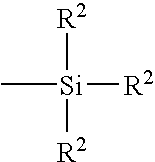Non-random styrene-butadiene rubber
a styrenebutadiene rubber, non-random technology, applied in the direction of special tyres, non-skid devices, transportation and packaging, etc., can solve the problems of tire traction characteristics that provide even lower rolling resistance to be demanded by consumers, blends that are not totally satisfactory for all purposes, and tire traction characteristics that provide excellent traction characteristics and low rolling resistan
- Summary
- Abstract
- Description
- Claims
- Application Information
AI Technical Summary
Benefits of technology
Problems solved by technology
Method used
Image
Examples
examples 1 – 4
Examples 1–4
[0058]In this series of experiments, a copolymerization of 1,3-butadiene and styrene was conducted on a continuous basis. These polymerizations were conducted in a continuous reactor chain that included a first reactor having a capacity of 5 gallons (19 liters) and a second reactor having a capacity of 10 gallons (38 liters). The reactors were jacketed for temperature control and were agitated with 2 axial flow turbine (AFT) impellers in each reactor. The reactors were run liquid full by pressure feeding in the bottom and exiting from the top of each reactor. Process flows and reactor temperatures were controlled by a distributed control system with appropriate instrumentation and valve control.
[0059]The primary monomer premix (50% monomer in hexane) was recirculated through the appropriate premix tank drying beds containing molecular sieves and silica gel. The premix flow was then fed (single pass) through the large drying beds that also contained molecular sieves and s...
example 1
[0061]Primary premix feed: 50% monomer in hexane at 96.53 g / min (21% styrene / 79% butadiene)
[0062]Hexane feed: 171.61 g / min
[0063]Overall monomer concentration: 18%
[0064]Reactor temperatures: 88° C. in the first reactor, 96° C. in the second reactor
[0065]Total Reaction Residence time: 2.4 hours (first and second reactors)
[0066]n-BuLi: 1.0 mmoles / 100 g monomer (mmphm)
[0067]TMEDA: 0.08 moles / mole n-BuLi
[0068]DVB: 0.05 moles / mole n-BuLi (for cold flow inhibition)
[0069]1,2-butadiene: 175 ppm on total monomer
example 2
[0070]In this experiment the polymerization temperature was increased with respect to the temperature utilized in Example 1. The process conditions used were as follows:
[0071]Primary premix feed: 50% monomer in hexane at 96.53 g / min (21% styrene / 79% butadiene)
[0072]Hexane feed: 171.61 g / min
[0073]Overall monomer concentration: 18%
[0074]Reactor temperatures: 99° C. in the first reactor, 104° C. in the second reactor
[0075]Total Reaction Residence time: 2.4 hours (total in the first and second reactors)
[0076]n-BuLi: 1.0 mmoles / 100 g monomer (mmphm)
[0077]TMEDA: 0.08 moles / mole n-BuLi
[0078]DVB: 0.05 moles / mole n-BuLi (for cold flow inhibition)
[0079]1,2-butadiene: 175 ppm on total monomer
PUM
| Property | Measurement | Unit |
|---|---|---|
| glass transition temperature | aaaaa | aaaaa |
| glass transition temperature | aaaaa | aaaaa |
| temperature | aaaaa | aaaaa |
Abstract
Description
Claims
Application Information
 Login to View More
Login to View More - R&D
- Intellectual Property
- Life Sciences
- Materials
- Tech Scout
- Unparalleled Data Quality
- Higher Quality Content
- 60% Fewer Hallucinations
Browse by: Latest US Patents, China's latest patents, Technical Efficacy Thesaurus, Application Domain, Technology Topic, Popular Technical Reports.
© 2025 PatSnap. All rights reserved.Legal|Privacy policy|Modern Slavery Act Transparency Statement|Sitemap|About US| Contact US: help@patsnap.com


